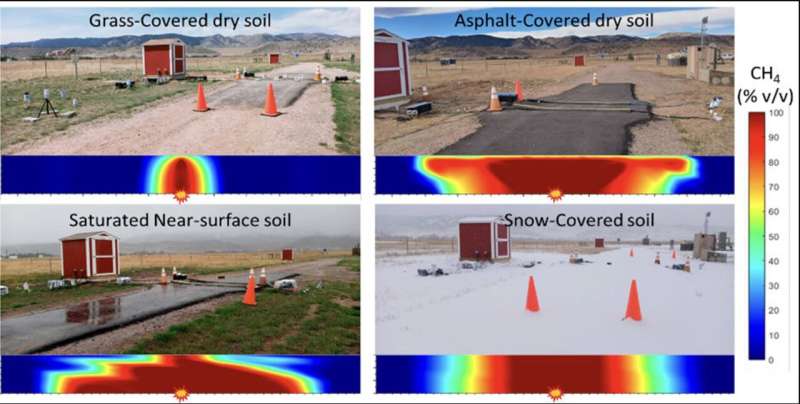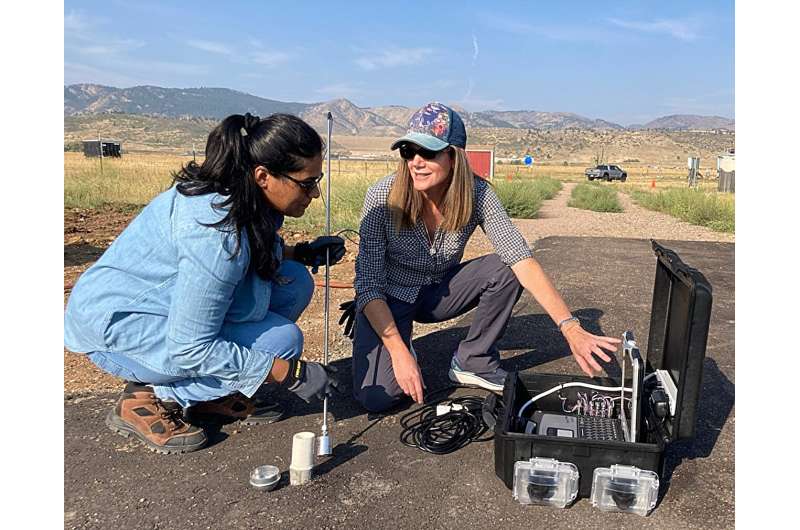This article has been reviewed according to Science X's editorial process and policies. Editors have highlighted the following attributes while ensuring the content's credibility:
fact-checked
trusted source
proofread
Ground surface conditions found to impact speed and distance of leaking natural gas

When natural gas leaks from a subsurface pipeline, a ground cover of water/snow saturation, asphalt paving or a combination of these can cause the gas to migrate away from the leak site up to three to four times farther than through dry soil, a new study has found.
A Southern Methodist University (SMU)-led research team also found that these surface conditions can impact the speed of the leaked gas, as well, traveling 3.5 times faster than an equivalent leak under dry soil conditions.
"This work is highly significant, as for the first time, it links the impact of changes in surface conditions to belowground gas transport times and distances," said SMU's Kathleen M. Smits, one of the co-authors of the study published in the journal Environmental Science & Technology Letters.
It's critical for first responders and gas and oil companies to factor in soil surface structures when evaluating the safety risk of a pipeline leak to nearby homes and businesses, said Smits, SMU Lyle School of Engineering Chair of Civil and Environmental Engineering and Solomon Professor for Global Development.
There are two hazards at stake in these pipeline leaks: Uncombusted natural gas, made mostly of methane (CH4), has the potential to cause an explosion, but methane is also the second-largest contributor to global warming after carbon dioxide (CO2). Finding all locations where methane gas seeps from leaking pipelines—and removing that gas safely—could cut down on global warming, Smits said.
"The findings of this study provide crucial insight into identifying and prioritizing leaks from the perspectives of both safety and the environment," Smits said.
The research team led by SMU conducted controlled leak experiments at Colorado State University's Methane Emissions Technology Evaluation Center (METEC) underneath the following soil surface structures: snow or rain on top of grass, grass-covered dry soil or asphalt that was either dry, wet with rain or snowed on.
Here, the researchers were able to safely leak gas from a cracked pipeline, then observe how far the gas leaked vertically and horizontally over specific points of time after the leak. For each experiment, natural gas was continuously released at predetermined leak rates for up to 24 hours to mimic the way gas would seep out in a real scenario.
Navodi Jayarathne, a postdoctoral researcher in SMU Lyle School's Civil and Engineering Department, was the study lead. Also assisting were Daniel J. Zimmerle, Director and Principal Director of the Methane Emissions Technology Evaluation Center at CSU; Richard S. Kolodziej IV, who is getting a master's degree from SMU and is part of Smits' research team; and Stuart Riddick, a research scientist at Colorado State University's Energy Institute.
Key findings
The researchers found that rain, snow, and asphalt were shown to block gas from escaping the soil at the surface, resulting in gas migrating both downward and outward away from the leak location.
Imagine the gas traveling through something like a slab of Swiss cheese, Jayarathne explained. The gaps or "holes" in the soil that can be filled by water, gas or other particles.
"Because of that, gas keeps migrating through the soil to far distances and increases the potential risk," explained Jayarathne.

In addition, "we found that in the case of an asphalt, moisture or snow condition, when the gas does eventually find a place to escape the soil, it moves very fast and at high concentrations, increasing the safety risk," Smits said.
Another finding surprised the researchers: Even after the gas supply was terminated or the leak fixed, methane trapped under snow, moist soil or asphalt surface conditions could still be detected at a high concentration for up to 12 days. And natural gas spread laterally away from the leak source by up to 2 to 4% during that time.
"Previous data shows that gas will vent out of the soil quickly after the gas is stopped," Smits said. "But this study shows gas venting is unique based on the surroundings, especially the surface."
First responders should be aware that the gas site will continue to evolve after the leak is stopped, Smits said.
Researchers noted that the migration distances they recorded are based on the METEC's soil type and condition.
"Values may be different when applied to other locations and environments. However, the patterns will reflect the expected behaviors from other leak locations, too," Smits said.
More information: J R R Navodi Jayarathne et al, Flow and Transport of Methane from Leaking Underground Pipelines: Effects of Soil Surface Conditions and Implications for Natural Gas Leak Classification, Environmental Science & Technology Letters (2024). DOI: 10.1021/acs.estlett.4c00039
Provided by Southern Methodist University


















